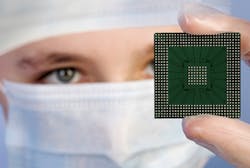UL SEMI Services
Semiconductor Equipment and Materials International (SEMI®) is the global industry association serving the manufacturing supply chain for the micro- and nano-electronics industries, including:
- Semiconductors
- Photovoltaics (PV)
- LED
- Flat panel display (FPD)
- Micro-electromechanical systems (MEMS)
- Printed and flexible electronics
- Related micro- and nano-electronics
SEMI has developed a set of guidelines that address the performance and safety of semiconductor equipment. There are 24 separate standards ranging from S1 - Safety Guideline for Equipment Safety Labels to S26 - Environmental, Health, and Safety Guideline for FPD Manufacturing System. These guidelines are created and periodically updated by industry working groups.
Underwriters Laboratories certifies compliance to SEMI S2, Environmental, Health, and Safety Guideline for Semiconductor Manufacturing Equipment, SEMI S8, Safety Guidelines for Ergonomics Engineering of Semiconductor Manufacturing Equipment, and SEMI S14, Safety Guidelines for Fire Risk Assessment and Mitigation for Semiconductor Manufacturing Equipment.
Increasingly, compliance to SEMI S2, including S8 and S14, is appearing on purchase orders and engineering specifications. Compliance is often demonstrated through a report that is typically created by an independent third party. UL's machinery assessment services team can prepare a complete report after evaluating equipment to SEMI S2 requirements.
SEMI S8 provides ergonomic design principles and considerations for semiconductor manufacturing equipment. It was developed to provide guidelines for a flexible partnership between the equipment manufacturer and the equipment purchaser. Adhering to these guidelines promotes compatibility in the integration of user personnel and equipment within a semiconductor manufacturing environment. These guidelines apply to the design, installation, operation, maintenance, and service of semiconductor manufacturing equipment; UL can help you assure compliance to SEMI S8.
SEMI S14 provides considerations to the manufacturers of semiconductor manufacturing equipment that will assist them in assessing and mitigating the risk to equipment and product associated with fire and combustion by-products. Although these guidelines are written as an assessment tool, they are intended for use throughout the design and development of semiconductor manufacturing equipment. They may also be used by the users of such equipment and by other interested parties to assess and compare the described risks of various equipment designs or in the design and evaluation of ancillary equipment or modifications. The guidelines are not intended to specify which techniques (e.g., selection of materials or detection systems) are to be used to mitigate fire risk, but they do recommend that the traditional risk management hierarchy of elimination, engineering controls, administrative controls, warning, and work practices be followed. UL can verify the appropriate application of SEMI S14 guidelines and provide a report that identifies, analyzes and assesses residual fire risks.
For more information on UL SEMI Safety Guideline services, please contact Kevin Connelly at 631-546-2691 or [email protected] or go to the Web at http://www.ul.com/global/eng/pages/offerings/industries/powerandcontrols/semiconductor/

